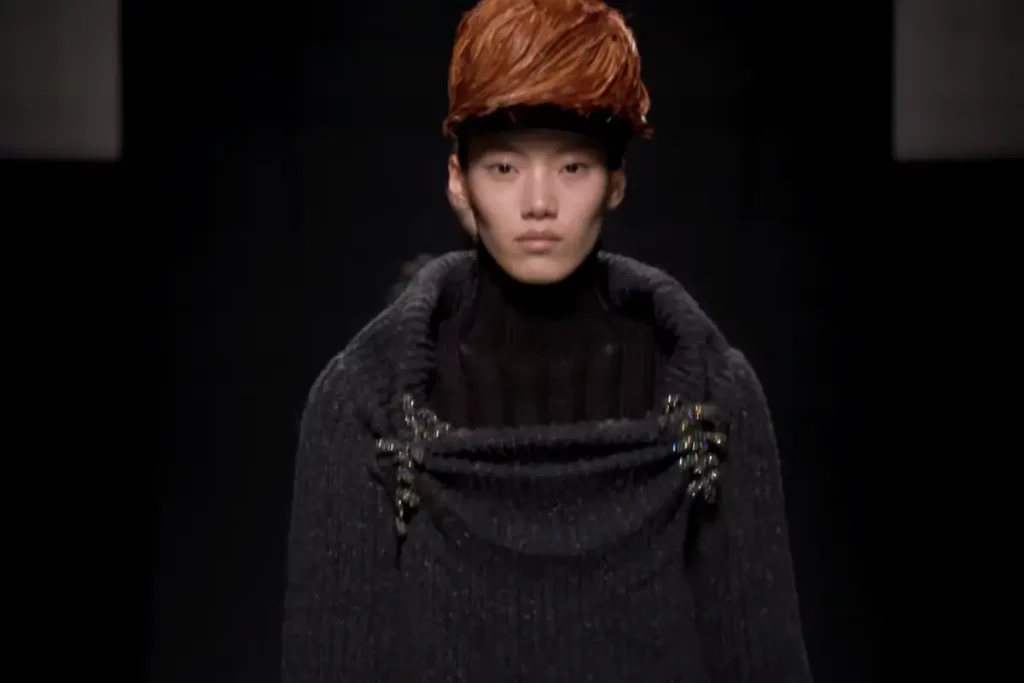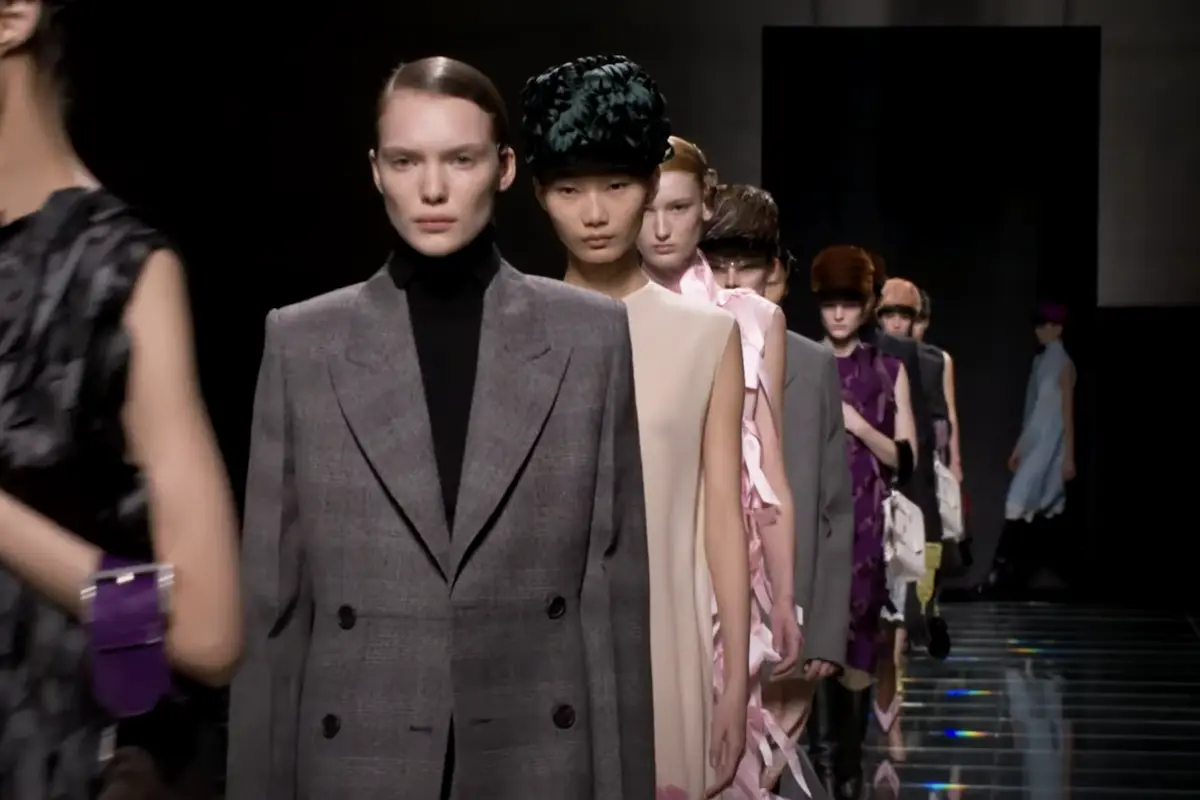The fashion industry remains obsessed with Prada: the identity of the bourgeoisie, the intellectual irony of a lady who walks with brisk steps, the pride of a woman who identifies Milan and the Milanese
It rains in Milan and Prada is doing the show
It rains in Milan while Prada shows. The cab driver says that in Milan when it is rainy everyone uses a car. He says once it used to rain all the time, now it pours four times a year and looks like the apocalypse. This is not even if we were in Rome.
Today the inducement increases little for the taxi drivers – what increases is the traffic. Fashionistas run around with drivers available all day. In any case, one does not strike when the city welcomes merchants. It is the city that runs the business, not the category. The cab smells bad at 7:15am – but there is pride in driving in the rain.
Raf Simons’ sign gains space on Prada’s sheet
The tools and elements remain those of the Lady (in Milan Miuccia Prada, it is called la Signora, the Lady), but gradually, one collection after another, Raf Simons’ identity appears more pronounced. The transition is proceeding slowly: the solution to continuity does not want to be perceptible. It would be naive to think this is a collaboration. They showed mutual admiration, met, clashed more, and came to an agreement. It was not just a proposal by Prada in response to Simons’ willingness.
It was, as it continues to be, about two designers who in the course of their existence have found the seriousness, the complication that can be understood as sophistication (without intending this word as praise). In simpler words: who else could take Prada’s reins next to the Lady? Was there an alternative on the market? Or again – was there a different direction for these two figures than the one that brought them together? Market, customers and public: those who like fashion that is an intellectual sign before an aesthetic one are the ones who wear Prada.
Who are Prada’s customers today?
Do Prada women, the original ones, still exist? The clients who understand the daring, the irony of ugliness, the awkwardness that becomes carelessness: the fast-paced walk, half heel, high pelvis, sweater at the waist – and the skirt below the knee, with the hemline high. Are there still women who are like this, or are we left with only girls who imitate what they cannot understand? Girls who belittle both the Prada uniform, the Milan it represents, and themselves.
In the context of a Prada show it all makes sense – but do these women exist in the real world? This contradiction now seems to be able to proceed, or perhaps endure – but will it continue? How long? The point remains at the origin: if you remove the foundation, will the building still stand? The Milanese, middle-class lady to whom Ms. Prada refers, where has she been?
In Paris there is the one from the Left Bank who gets out of bed with the boy from the night before and steals a shirt from him, hair disheveled, no makeup, brim hat and at best the frenulum between the two incisors never severed – if the shirt stolen from the boy’s closet is white, we opt for Saint Laurent – if the shirt is in check, we are with Slimane. These careless divas are the image of Paris, just as Prada’s bourgeois lady is the image of Milan. She is so bourgeois that the only thing that horrifies her is the word bourgeois. The lady with a communist passion. Women like Hunter Schafer are dressed in Prada today – she is not Italian and can be seen as a catalyst for accepting gender dysphoria.

The women of Milan for Lady Prada: Cini Boeri, Giulia Maria Crespi, Gae Aulenti, the Countess of Monza
Lady Prada reminds all the other responsive bourgeois and Milanese that every misfortune can be laughed at – and discussed with a guy from Belgium. The intellectual irony. Cini Boeri could have answered her in kind – as well as Giulia Maria Crespi, Gae Aulenti or the Countess of Monza. This was while maintaining the dialogue acumen Lina Sotis used for one of her blurbs. Today among the ranks, approaching to find the numbered seat, one notices boredly those pretty ones named Chiara, always too much make-up and always with too many sequins on – along with the journalist who, no matter how hard she tries, will never be able to write it.
The fashion show was on for the coming season: there are tailoring details, letter carriers or gendarme hats without becoming costumes. The ribbon belts, the redingotes and stylized polka dots. There is less irony and more concept – Simons brings with him the Northern school: when the redingotes are tipped at the front-leaving the vest opening on the back, it is more a form of literature than dress. Single-color ribbon embellishments are erroneous frequencies.
Prada – fashion is about measurement, before obsession
Prada’s fashion – or rather – the fashion that Prada governs, leads and teaches, is a matter of measure. Also of manner and attitude, of course – but first, of measure. The concept, that is, the field where Raf Simons is prioritized, comes after the size of the lady. In these years, side by side, let this be the constant reasoning in their confrontation: how to understand, feel, sense and perceive the measure. Milan is the city of measure.
Perhaps it is easier to find the woman of Jil Sander today in Milan – rather than the woman of Prada. Jil Sander’s woman is a virile and mathematical virago, cold, monochromatic, uncompromising. Prada’s woman may also be sullen, ugly, and more sophisticated in her after-dinner chat, between a tuberose, lipstick-stained chocolate bar, or a smoking cigarette, but she will still crave an ambitious, beardless young adult to make her laugh.
Intellectual effort, fashion, and obsession
The fashion industry is obsessed with Prada. True, there is an even more dramatic obsession, than this one for Prada, that the industry suffers from – the obsession with Hedi Slimane. Compared to Prada, Hedi Slimane is unapproachable, detached and indifferent – the obsession remains silent, intimate, reserved. The fashion industry-not fashion per se-is a community of obsessed people. Those who succeed in this industry are obsessed.
By fashion industry we do not just mean the community of those who make and sell clothes – but we mean a system that produces graphics, photography, that subsidizes art and cultural institutions, that catalyzes students’ endeavors everywhere. The question is upstream – is the fashion industry intellectually adept at such obsessions? Most people would answer no – and rightly so if you want to spend three minutes following the video released by Business of Fashion and listening to the editor’s posed questions. The dialogue asks why Prada is influential? And the answers is, «because it’s good» (Katie Grand).
Prada’s intellectual irony is humble. Note that the people involved in that video are not influencers engaged in a selfie, but profiles that move thousands of dollars with their decisions. If all the cultural depth behind the creation of an imaginary (which in English is summed up in the word brand) is reduced to pleasantry-type conversations with many adjectives, skepticism sets in. Fashion industry obsessives appear negligible in their carnival.
The carnival we see on the streets: random people, various tourists, people who want to be somebody instead of being themselves. All of these things we dislike in Milan. The Milanese never confuse carnival: the Milanese know that carnival is a subject of Lent and pastries, of children with magic wands and streamers – and of snow that one day remains in the parks.
In this obsession context, Milan remains the city of measure
The measure of Milan is what Prada has taught the city with his walking-short steps on half a heel. It is the same measure Giorgio Armani talks about at the conclusion of each fashion show. Armani’s fashion industry has no obsession – but Italians do. Giorgio Armani is perhaps the man Italians admire without delay, when he still fixes the detail in a shop window, when he gets annoyed by boisterous women on the street, when he dismisses fashion itself as a vulgar word.
Everyone-except those obsessed with fashion-but how many are there in the end? – remain on Giorgio Armani’s side. It’s not fashion, all right-but at a time, like this ours, when neon colors, synthetic fabrics and leather abuse seem irrelevant, Armani proceeds with relaxed tailoring (so relaxed that he could do without plastic sequins). Giorgio Armani has never been bourgeois.
When it rains in Milan, we have everything we require: clean air. We need rain, we need more of it – just as it used to rain and as cab drivers remember. Shiny branches of bare trees. We will have time to plant more lime trees, create new businesses, businesses, industries, and more jobs.
The bourgeois lady will still use her intellectual irony: she will help her husband update the ethics of the master: that is, an entrepreneur who knows how to take care of his employees better than the state can, offering him a system so advantageous and protected that this employee will want to find the will and the nails to not be deprived of it by dismissal. It is always about measurement. Besides rain and snow, Milan lacks pride.



















